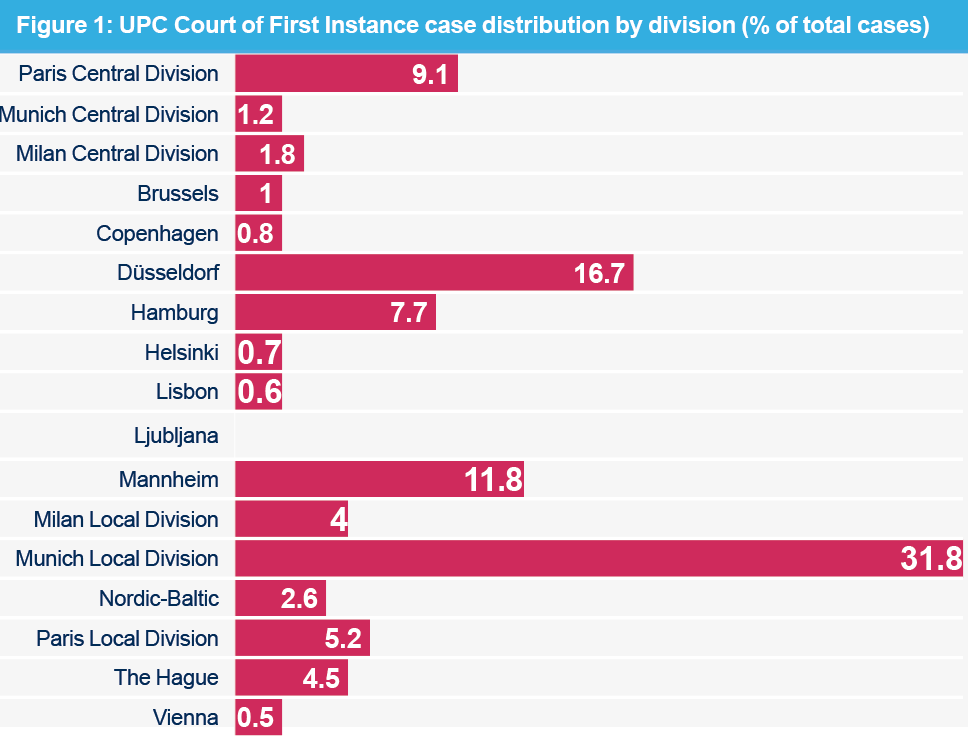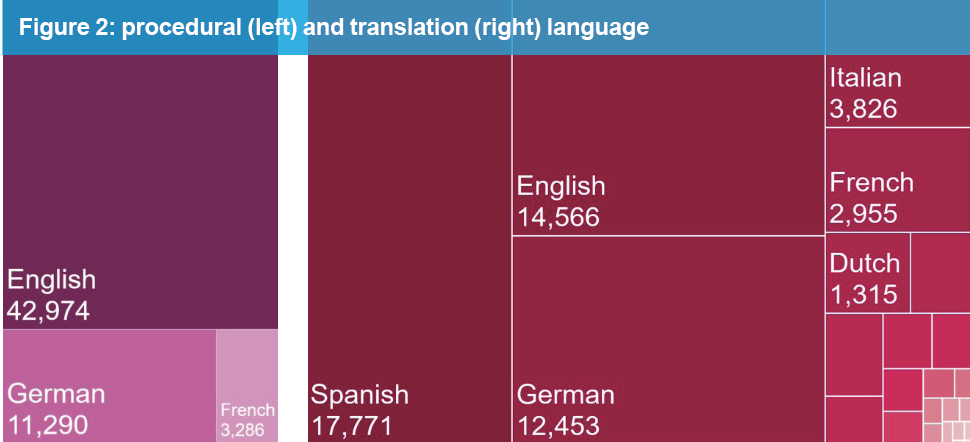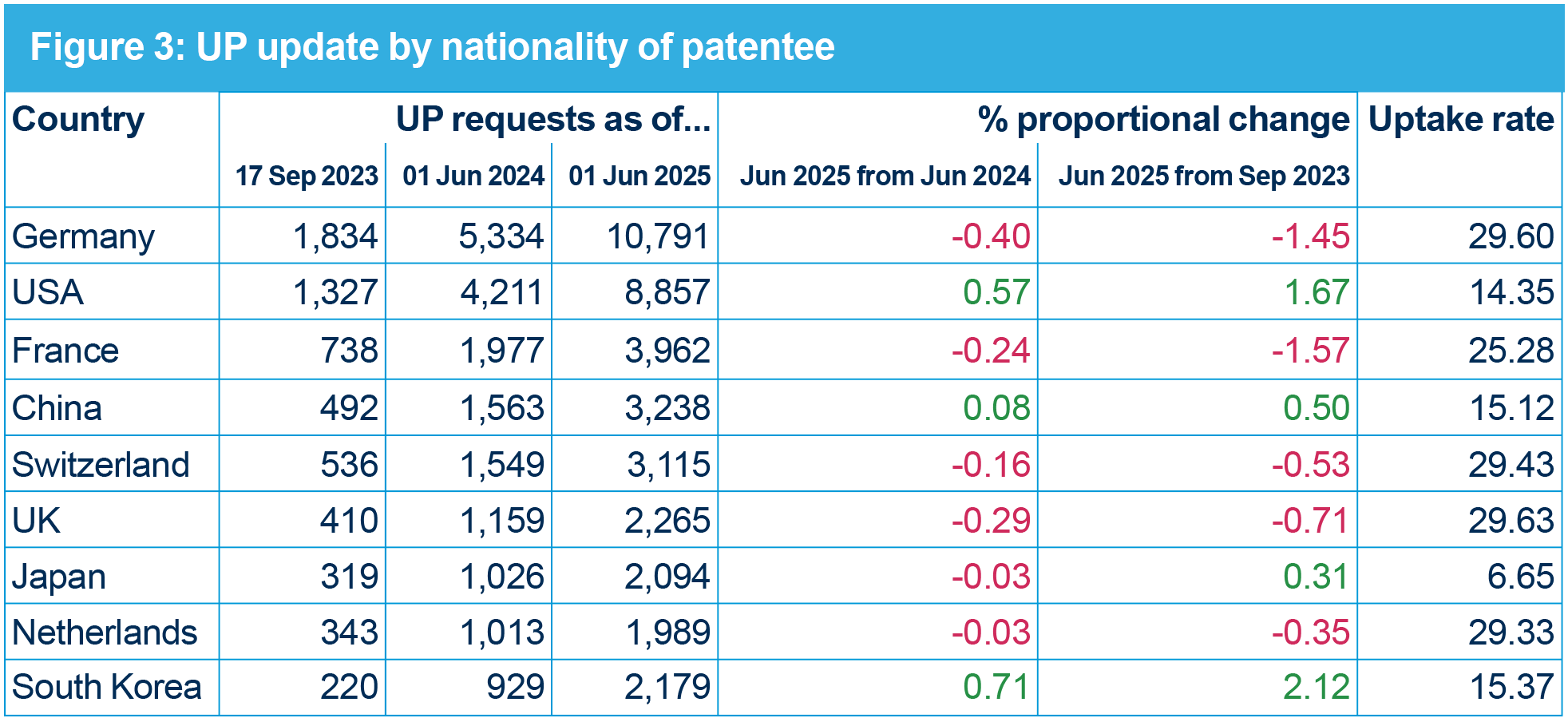UP & UPC statistics and trends: a two-year check in
In the two years since the UPC opened, patentees have also been able to protect their inventions across Europe through obtaining unitary patents (UPs), which increased in territorial scope from 01 September 2024 when Romania became the 18th member state of the UPC. This article takes a look at how various trends are developing as we pass the two-year mark.
UPC Court of First Instance
On 05 June 2025, the UPC published an update on the case load of the courts, covering 01 June 2023 to 31 May 2025. As of 31 May 2025, 883 cases have been filed before the Courts of First Instance. This includes 320 infringement actions and 369 revocation actions. Of these 883 cases, the breakdown across the First Instance Courts is as shown in figure 1 below.

Infringement
In respect of infringement actions, the German Local Divisions still lead the way, with 244 actions (over 75% of the total number) being filed across the Munich, Düsseldorf, Manheim and Hamburg Local Divisions; the four most popular first instance courts. The Paris, Hague, and Milan Local Divisions are also fairly frequently used for filing infringement actions, but the Nordic-Baltic regional division (which appeared popular during the initial months of the UPC) has only seen a single infringement action lodged during the past 12 months. Only three infringement actions have been initiated before a Central Division court (two in Paris and one in Milan), while the Munich Central Division and Ljubljana Local Division have yet to hear any infringement cases.
Revocation
Over the past two years, 65 standalone revocation actions have now been filed, with the 47 lodged at the Paris Central Division representing the lion’s share. This is dwarfed however by the 304 counterclaims for revocation which have been lodged by defendants across 174 infringement cases (many of which have multiple defendants bringing their own separate counterclaims).
The number of bifurcated proceedings at the UPC has been relatively low so far, with the UPC by default being a non-bifurcated system. Local and Regional Divisions have seemed more willing to bifurcate when a standalone revocation action is already pending before a Central Civision for the same patent in respect of which a revocation counterclaim has been filed (for example, in MED-EL Elektromedizinische Geräte GmbH v Advanced Bionics (GmbH & Sarl): UPC-CFI_410/2023).
Other applications
The UPC First Instance Courts have seen a number of other applications over their first 24 months; 66 for provisional measures, 18 for preserving evidence, three for orders for inspection and one each for an order to freeze assets and a request for damages. There have also been 4 applications filed for a declaration of non-infringement, and 97 applications for a decision on costs.
UPC Court of Appeal
As we cross the threshold into the UPC’s third year, enough time has passed for a number of early-filed cases to have been heard by the Court of Appeal in Luxembourg. In total, there have been 279 appeals, requests, and applications now filed at the Court of Appeal. This includes 70 appeals against decisions issued by the first instance courts, and 42 appeals against orders issued by those courts. There have also been 85 appeals filed in respect of preliminary orders, and 6 against issued cost decisions. In addition to this, there have been applications filed for suspensive effect and orders for expedition of appeal (27 each), 18 requests for discretionary review, and four applications for rehearing under RoP 245.
UP requests and uptake rate
As of 02 June 2025, 57,500 UPs have been registered, with another 627 requests pending, 77 requests rejected, 53 requests withdrawn, and 326 registered UPs now lapsed. With the number being 28,326 on 01 June 2025, the number of UP requests filed in the second 12 months of the UP and UPC is almost exactly the same as the number filed in the first 12 months. In 2024, the uptake rate of UPs (the number of granted European patents for which unitary effect was requested) was 25.6%, a significant increase on 2023’s 17.5%. During 2025 to date, the uptake rate is up to 27.7%, demonstrating that the popularity of the UP is still growing. This may be partly due to the increasing strength of the UP, with UPs having covered Romania since 01 September 2024. With the UPC and UP systems now having been in existence for just over two years, patent proprietors may also now have more familiarity and confidence in the system.
The global uptake rate is 22.5% as of 02 June 2025. However, for patent proprietors based in EPC states, this rises to 32.3%, and for those based only in EU states, up to 32.9%. While patentees from around the world are utilising the unitary patent system, it is still European patentees with the highest uptake rate.
The relative share of UPs obtained by technical field remains fairly well distributed, with no technology fields seeing their share fall or rise particularly sharply.
Language choices
Upon filing a request for unitary effect to obtain a UP, a full translation of the patent specification in one of the languages of the European Union must be filed. A little over a quarter of these translated specifications (where the procedural language of the patent is French or German) must be English. However, for all patents where the procedural language of the patent is English, it is up to the applicant to choose the language of translation.
The most popular choice of translation language for UP requests remains Spanish. In fact, its popularity has increased from 40.7% of all UP requests for patents where the procedural language of the patent is English 12 months ago to 41.4% now. This therefore represents 30.9% of all requests for unitary effect being accompanied by a filing of a translation of the patent into Spanish. This demonstrates that Spanish is becoming established as the primary UP translation language of choice for UP holders. Since obtaining patent protection in Spain also requires a full translation of the specification into Spanish, patentees are therefore able to make use of this same translation to obtain a UP and a Spanish national patent.
At the UPC, English is still the predominant language at the Court of First Instance despite the fact that the German divisions are favoured by applicants. Indeed, the share of proceedings in which English is used as the language of proceedings has now increased to 55%, with German dropping to 38%, French at 3%, Italian at roughly 2% and Danish and Dutch both at around 1%.

UP requests by country of applicant
Figure 3 below shows the number of UP requests across patentees from nine different countries; three which are members of the UPC and EU (Germany, France, and the Netherlands), one of which is a contracting state only of the UPC (Switzerland), one of which is an EPC contracting state but not a UPC or EU member state (the UK), and four-non European countries; the USA, Japan, China, and South Korea. As can be seen, the European-based countries (and specifically those which are UPC contracting states) have a higher uptake than the non-European countries. However, interestingly, it appears that there has been some catching up over the past 12 months in terms of the outright numbers of UPs being requested by non-European based patentees particularly. The columns showing the proportional change with the numbers in red and green indicate the changes in the share of UPs requested among these nine countries. So, for example, while South Korean patent proprietors were responsible only for 3.54% of UPs obtained up to 17 September 2023 (220 of a total 6,219 among the nine countries listed), this grew to 4.95% by 01 June 2024, and further to 5.66% of all UPs across the nine listed countries by 01 June 2025.
This means that, though the uptake rate is still lower (particularly in Japan, which is becoming an outlier), non-European based patentees are beginning to grow their share of total UPs owned, demonstrating perhaps that knowledge of and confidence in the UP and UPC systems is now increasing around the world.


